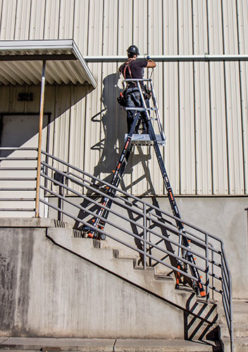Stepladder safety
How do I maintain three points of contact when working from a stepladder?

Responding is Dave Francis, national safety director, Little Giant Ladder Systems Inc., Springville, UT.
This is the most common question I hear when teaching ladder safety classes is. The answer should be easy. I should just have to ask, “What does the standard say?”
The problem, however, is that the OSHA standard (1926.1053(b)(21)) isn’t clear. It says, “Each employee shall use at least one hand to grasp the ladder when progressing up and/or down the ladder.”
The standard addresses only what to do when moving up or down the ladder, not what you should do when you stop to work. It’s clear to most people that the only reason you would be climbing an A-frame or stepladder is to do something. That “something” almost always will require you to use both hands.
The safe interpretation
So, how do you get the work done and maintain three points of contact? Most people tell me they lean their body into the ladder to maintain balance using their hip or stomach as the third point of contact. The European standard provides a little more detail: “Keep two feet on the same step and the body (knees or chest) supported by the stepladder to maintain three points of contact.”
Although this standard is a helpful guideline, workers can still have issues because some companies have a more restricting definition of three points in their company safety policies. Many safety professionals have told me that if their workers need both hands to work while on a ladder, they need to be tied off from above. This rule might sound like a best practice, but it can cause some problems in its practical application. The climber not only would need a proper harness and lanyard, but also a certified anchor point with a safe way to connect to it without adding risk. Chances are you can’t think of many spots in your building with proper anchor points available to keep this rule, which leads to operators working in unsafe positions.
A solution
A new trend in the ladder industry provides a solution to this problem. Platform ladders with built-in guardrail systems can be a safe alternative to tying off. The platform provides a more comfortable surface to work from and the guardrail fulfills the need for fall protection without relying on nonexistent anchor points. These ladders, often made from nonconductive fiberglass, are climbed maintaining three points of contact. Once the user steps through the one-way gates at the top, he or she does not need to be tied off and can work with both hands. These ladders allow the operator to work in a fully enclosed working platform quickly and safely with two hands while still complying with industry regulations.
Instead of parking an ambulance at the bottom of the cliff, why not put a fence at the top?
Climb safe.
Editor's note: This article represents the independent views of the author and should not be construed as a National Safety Council endorsement.
Post a comment to this article
Safety+Health welcomes comments that promote respectful dialogue. Please stay on topic. Comments that contain personal attacks, profanity or abusive language – or those aggressively promoting products or services – will be removed. We reserve the right to determine which comments violate our comment policy. (Anonymous comments are welcome; merely skip the “name” field in the comment box. An email address is required but will not be included with your comment.)

